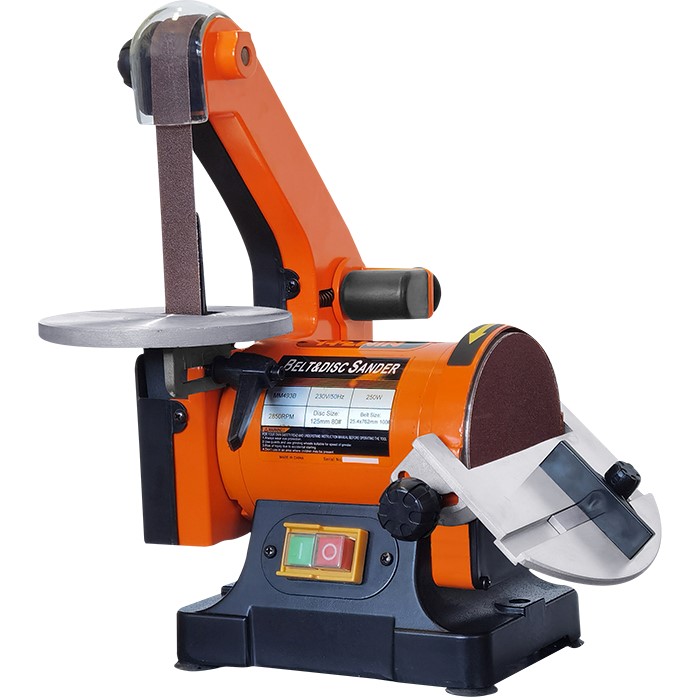A kəmər disk zımparabütün ağac emalı və DIY həvəskarlarının zımpara ehtiyacları üçün etibar edə biləcəyi möhkəm bir vasitədir. O, ağacdan kiçik və ya böyük material parçalarını tez bir zamanda çıxarmaq üçün istifadə olunur. Hamarlama, bitirmə və üyütmə bu alətin təklif etdiyi digər funksiyalardır. Bütün bu ehtiyacları ödəmək üçün o, ağac emalına layiq xüsusiyyətlər yığını ilə təchiz edilmişdir. Onlardan bəzilərinə güclü elektrik mühərriki, müxtəlif disk ölçüləri, müxtəlif qum səviyyələrində aşındırıcı səthləri olan kəmər və bütün yonqarlar üçün toz yuvası daxildir.
Beləliklə, uzun müddət davam edə biləcək və böyük funksionallıq təklif edə biləcək birini almadan əvvəl aşağıdakı xüsusiyyətlərin hamısına yaxından baxmaq vacibdir.
1. Disk/Kəmər Ölçüsü
Siz satın aldığınız zamandisk zımpara, nəzərə almalı olduğunuz ən vacib xüsusiyyətlərdən biri disk ölçüsüdür. Bu, faktiki zımpara diskinin diametrinə aiddir və əksər modellərdə beş ilə səkkiz düym arasında beş ilə 12 düym arasında dəyişə bilər. Daha kiçik disklər daha az səth sahəsinə diqqət yetirdiyiniz layihələrdə işləmək üçün idealdır. Bunun əksinə olaraq, adaha böyük disk zımparazımpara vaxtınızı azaltmağa kömək edə bilər. üçünkəmər zımparalar, tapa biləcəyiniz ən ümumi ölçü 4 düym eni 36 düym uzunluğundadır,Allwin elektrik alətlərihəmçinin 1 düym enində 30 düym uzunluğunda, 1 düym enində 42 düym uzunluğunda, 2 düym enində 42 düym uzunluğunda isteğe bağlı kəmərlər var.
2. Materiallar
Heç kim elektrik alətlərini hər layihə ilə daim əvəz etmək istəmir. Bunun qarşısını almaq üçün, istismar zamanı hərəkətin qarşısını almaq üçün onların davamlılığını və çəkisini artırmaq üçün çuqundan hazırlanmış zımparalara baxın.
3. Çəki
Güclü zımparalargüclü alətlər ola bilər, lakin siz onları ehtiyaclarınıza uyğun müxtəlif çəkilərdə tapa bilərsiniz. Daha ağır hər zaman daha yaxşı keyfiyyətin zəmanəti olmasa da, adətən daha ağır çəkiyə malik disk zımpara modellərinə diqqət yetirmək yaxşı bir mərcdir, çünki onlar da yüngülçəkili modellərdən daha uzun müddət davam edir.
4. Sürət
Diskin ölçüsünə əlavə olaraq sürəti də nəzərə almalısınız. üçünkəmər zımparalar, bu dəqiqədə futla (FPM) istinad edilir, halbukidisk zımparalardəqiqədə fırlanma sayına (RPM) istinad edəcək. Aşağı sürətlər sərt ağaclar üçün daha yaxşıdır, yüksək sürətli disklər isə yumşaq ağaclarla istifadə üçün mükəmməldir. Ancaq birdən çox diskli zımpara almaqdan fərqli olaraq, bir satın almağı düşünündəyişən sürətli kəmər disk zımparamüxtəlif materiallarla işləyə bilmək üçün Allwin elektrik alətləri.
5. Bucaqlar
Balıqçılıq xüsusilə birləşmə üçün vacib bir xüsusiyyətdirkəmər disk zımparalar. Tipik olaraq, disk əlavəsinin daha yüksək dəqiqlik üçün adətən layihənizi adətən sıfırdan 45 dərəcə bucaqlar arasında bucaqlamağa imkan verən bir göbələk ölçüsünə malik olduğunu görəcəksiniz. Eyni şəkildə, kəmər zımparası sıfırdan 90 dərəcəyə qədər başlıq verilə bilər.
Allwin-in müxtəlif ölçüləri ilə maraqlanırsınızsa, bizə sorğu göndərinkəmər disk zımpara.
Göndərmə vaxtı: 27 mart 2023-cü il



